What can the advertising industry learn from the Disney-owned animation studio – which is known for its storytelling power? Pixar offers five secrets to the company’s success, which advertisers can learn from.
And of course, there’s no better place than cinema to tell a story!
Matthew Luhn, Pixar’s story supervisor and self described ‘king of gags’, has spent more than 20 years working his magic on films including the Toy Story trilogy, Monsters Inc., and Finding Nemo, and definitely knows a thing or two about storytelling.
Watch any of Pixar’s 17 movies and you’ll see a storytelling masterclass in action! The films make the process look easy, but pull back the curtain and you’ll find an intensive four-year process that involves thorough research, consultations with experts and the use of data to enhance creative expression.
Following his appearance at a Cannes panel alongside data specialist Quantcast, Luhn met Campaign UK to share ‘five creative secrets of storytelling’ from the animation studio.
1. Empower the artists
At Pixar, the story always comes first. When choosing a new film to produce, a director pitches three ideas to a cross-disciplinary group of staff members that include the Chief Creative Officer, Merchandising, Finance and Technical Executives. All provide feedback, but the final say on which story to make will be from the Creatives.
Luhn says: “Pixar flipped the rules of how it usually works in Hollywood, where the people that make the final creative decisions aren’t the people who went to business school. Instead, we created a culture that empowered the artist.” “Improving the quality of the product is important, but working in a company where the best idea wins motivates staff to think creatively.”
2. Obsess over your audience connection
Having finalized the story, Pixar works towards ensuring the story engages as many people as possible – because it has to recoup huge production costs. “Animated films cost more than almost any kind of film, including live-action movies” Luhn explains.
“Which means, you are going to have to sell a lot more cinema tickets.”
Pixar’s stories play on universally shared emotions such as fear and desire. For example, every Toy Story film focuses on the fear of being abandoned. The goal is to create a story that truly connects with the audience – enabling them to empathize with the characters and share their emotional journey.
Pixar relies on research into human behaviour to create the strongest connection between the characters and their worlds and the audience. As Walt Disney once said: “We cannot do the fantastic things based on real, unless we first know the real.”
3. Use data to aid creative expression
Each film’s story world is properly researched.
This could mean:
Ratatouille – sending creatives to a French cooking class to learn the correct way to cut a carrot.
Toy Story – speaking to toy collectors to understand the correct terminology and the feelings that drive them.
Even more detailed data comes into play when drawing a film’s character and emotions. For example, have you found yourself rooting for a robot in Wall-e or getting upset by a fish in Finding Nemo? That’s probably because Pixar gives their characters ‘identifiable human traits’.
“We want to make sure the expressions on a character’s face are matching up with the same expressions we make as people,” Luhn says. Pixar consults experts including psychologists and cultural anthropologists from around the world: “So no matter who sees our film, everybody can relate to a character.”
During the development face of the story, animators usually look at their own faces in the mirror to capture more realistic facial expressions. Small movements – the movement of pupils for instance, are actually ‘top of the list’ of what makes a character relatable.
Luhn says: “with the new data we use now, we can make even more subtle expressions that make a more successful connection with the audience. It just helps us to do our job a tad better.”
4. Get feedback – but from the right people
Pixar is careful about who can provide feedback and how it interprets the findings.
For much of its creative process, they only ask for feedback from other filmmakers. The whole company is invited to regular screenings of the storyboards, but only asks the general audience for their opinion six months before a film is launched.
Pixar is more interested on the reactions of the general audience, and not so much on what the say. Did they get bored? Did they laugh in the right places? According to Luhn, the danger in asking for feedback from a general audience too early is that they will tell you what they want to see in the film. If you try to give them what they want, “that’s how you make a really bad movie”.
5. Fail faster to the best idea
“The great creators that have existed on this planet are the ones that have taken chances,” Luhn says.
But making mistakes can be expensive. “Creating great stories is all about eliminating the bad versions to get to the good ones,” he continues. “That means you have to be comfortable with failing, so before your money and time run out, you have the best possible idea or product to share with the world.”
Aside from paying incredible attention to detail, Pixar also has a wider goal, which is to make people feel good. As Luhn’s teacher told him on his first day at art school, you know you are an artists if you look at life and believe it could be better. And that’s a philosophy he has carried with him throughout his life at Pixar.
“Pixar doesn’t just want to make films that reflect reality. We want to make them a fantastical version of what it could be.”
And of course, like movies, brands too are stories and there’s no better place than cinema to tell them.
Here are some reasons why:
1. Ultimate platform to showcase brands
Cinema provides the most powerful medium to impact captive, attentive and engaged audiences with audio-visual storytelling.
2. Desirable audience
Cinema typically caters to a young and affluent audience with high disposable incomes.
3. Large and expanding footprint
The cinema footprint in the UAE is large (approximately 53 locations and 439 screens – out of which MVM covers 29 locations and 287 screens) – ushering large audiences for new blockbuster releases throughout the year.
4. Variety of cinema experiences
Over recent years, more and more cinema operators in the region have invested in cutting-edge cinema concepts and technology (3D, 4D, IMAX, Barco Escape) – pushing the boundaries of cinema-going. This in turn affords advertisers new and exciting formats of cinema advertising – guaranteed to create greater brand impact through storytelling.
5. Flexible advertising durations
MVM offers advertisers flexible on-screen advertising durations, which range from 30, 45, 60, 75 and 90 seconds. Therefore, with cinema, advertisers have the option of delivering longer and more compelling brand stories that aren’t subject to stringent slots.
It’s time you freed yourself from the confines of advertising! Create powerful brand stories and align your brand with cinema advertising – an unmatchable medium for storytelling.
Sources: Campaign UK
Sir John Hegarty (BBH founder and industry icon) alongside SAWA (Screen Advertising World Association) spoke at the recently concluded Cannes Lions International Festival of Creativity on the power of cinema and the work he did with the UN’s Global Goals “We Have A Plan” campaign that ran in cinemas globally.
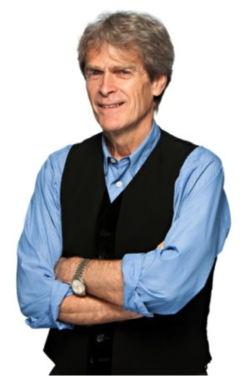
With the rise of increasingly disposable marketing channels such as Snapchat and short form video on Facebook and Instagram, there is a current view that brands need to make an impact within the first three seconds of a video, and often without audio.
However, according to BBH founder and advertising industry icon Hegarty, in a world of multi-platform messaging, marketers forget how powerful cinema is
“I constantly say the most powerful place to tell a story is in the cinema – it was conceived as a storytelling medium and we are telling a story,” he said.
“Marketers forget how powerful cinema is as a medium of capturing the zeitgeist – the public understand it but we sometimes forget it in a world of multi-messages. Cinema is a great place to tell a story and reach a captive and impressionable audiences.”
Back in September last year – in what went down in history as a game changer – Project everyone in partnership with SAWA utilized the power of cinema with the #FirstEverGlobalCinemaAd for the launch of the United Nations ‘Global Goals’ #WeHaveAPlan.
The commercial which was developed by Filmmaker Richard Curtis and creative lead Sir John Hegarty, together with Aardman Animations creating the animated cinema ad – premiered across 34 cinemas globally (including the UAE – at Motivate Val Morgan serviced cinema locations).
“Brands need to be profound wherever their message is running. Additionally, unifying them through all the media channels (including cinema) is what’s most important,” concluded Hegarty.
Here are related articles on why cinema is a powerful medium for advertising:
Cinema Advertising Demonstrates the Value of a Receptive Audience
Achieve Greater Brand Impact with 4D Cinema Advertising
Make Cinema An Integral Part of Your Media Plan
Source: adnews.com.au
Motivate Val Morgan offers 360 degree exposure and innovative opportunities to brands – utilizing both on-screen and off-screen advertising.
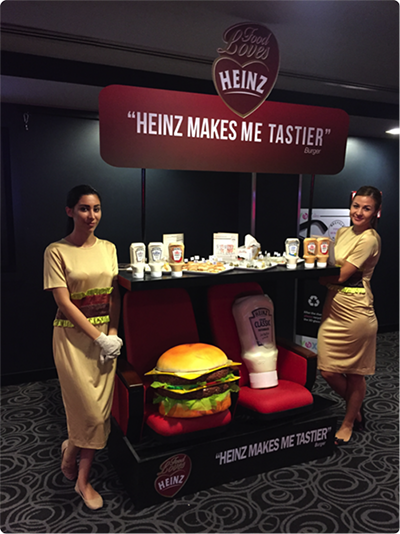
For brands wanting to sample their new product or present it in a theatre, a cinema promotion or sampling campaign definitely hits the spot!
Heinz (globally-trusted producer of high-quality, great tasting and nutritional foods) executed a sampling activity over the EID Weekend, across two of the most prominent VOX Cinema locations in Dubai – City Centre Deira & Mirdiff City Centre.
Heinz promoted their new flavours of mayonnaise – Garlic, Classic, Chili, Light and Tikka Masala, targeting moviegoers of two major blockbusters that released over the EID Weekend – ‘Independence Day: Resurgence’ and ‘Sultan’ (Hindi). Product sample and snacks with mayo recipe leaflets were also distributed.
Food sampling consists of one sample table stand with two branded promoters engaging cinemagoers- promoting and offering food samples of the product.
In the off-screen space, MVM offers a host of promotion activities to compliment and support on-screen advertising ranging from:
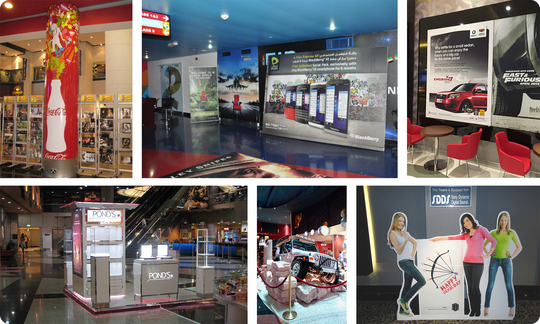
Want to know more on how off-screen cinema advertising could help move your brand closer to its target audience?
Contact a member of our sales team for more information.
Motivate Val Morgan is excited to welcome the newest Oscar Cinema location into its circuit – Barari Outlet Mall, Al Ain.
The newest facility by Oscar Cinemas LLC opened its doors to the public on Thursday 30th June, with the chain now having 6 cinema locations across the UAE:
Abu Dhabi
Al Ain
Sharjah
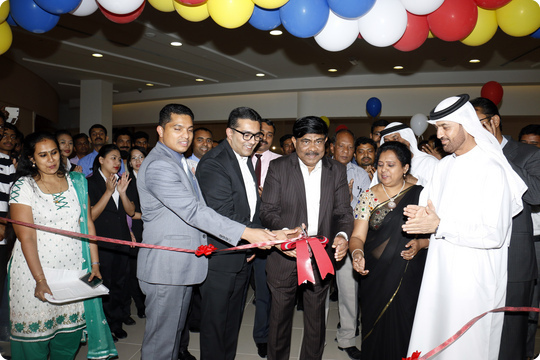
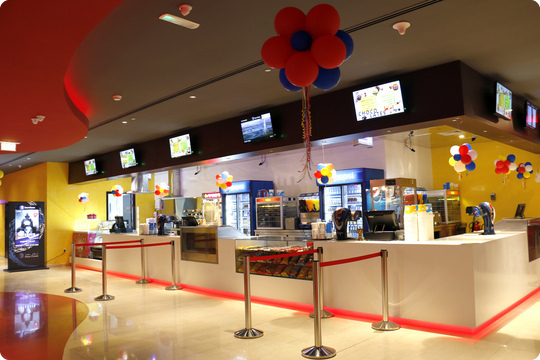
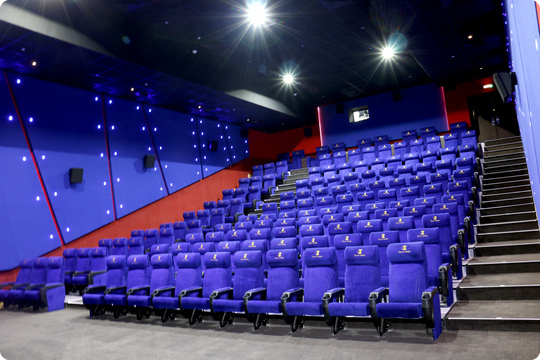
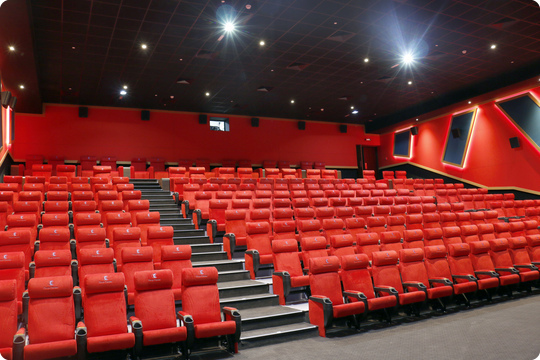
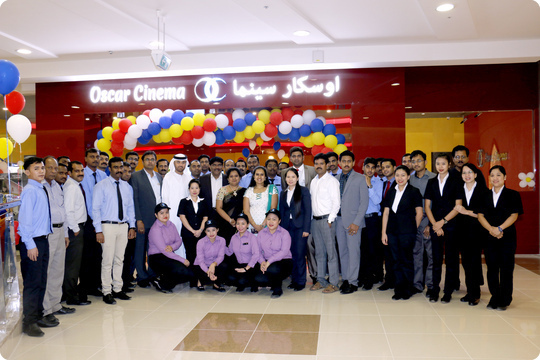
Oscar Cinema LLC is the brainchild by Mr. M. M. Kabeer, Managing Director & Founder, and the cinema chain shows the latest movies releasing every week from Hollywood, Bollywood, Arabic, and major regional Indian and Asian languages.
The growth of MVM’s operators has been pivotal to the growth of our circuit in the UAE (29 locations and around 290 screens) also resulting in the expansion of our company and team.
Our warm congratulations to the team at Oscar Cinemas.
Cinema advertising might be just the ticket to reach a diversified audience – the mature and younger early adopters, with your local media mix.
In today’s technology-saturated culture of smartphones, tablets, DVRs and online streaming channels, the ability to selectively choose entertainment at one’s fingertips that suits their schedule – without annoyance of advertising, poses multiple problems for marketers in the UAE and across the globe.
Frustrated of not being able to reach your target audience?
Cinema advertising helps you reach a fully attentive and engaged audience who has paid money to see your message on the big screen. Could it get any easier?
So, why add cinema advertising to your marketing mix?
There are 3 key factors driving the new era of cinema – that have continued to be prominent in 2016 and will continue to grow in the years ahead:
1. Investment in Infrastructure
Middle Eastern box offices have enjoyed double-digit annual growth in recent years, owing in many cases to the expanding network of cinemas that have been developed across the Middle East.
The cinema footprint in the UAE continues to grow with operators delivering more purpose built multiplexes and redeveloped locations with exciting cinema experiences for cinemagoers.
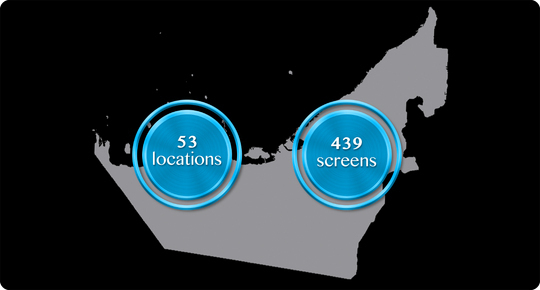
MVM’s circuit expansion and redevelopment projects in 2016 (to date):
VOX Cinemas – Galleria Rooftop (March 2016)

Reel Cinemas – City Walk (March 2016)
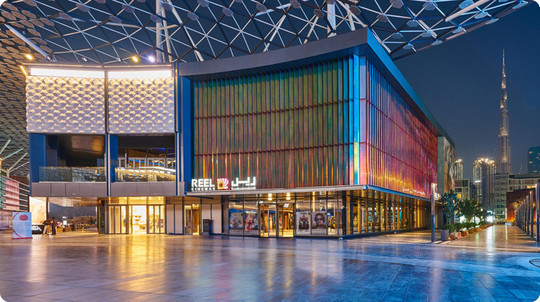
Oscar Cinemas – Barari Outlet Mall (July 2016)
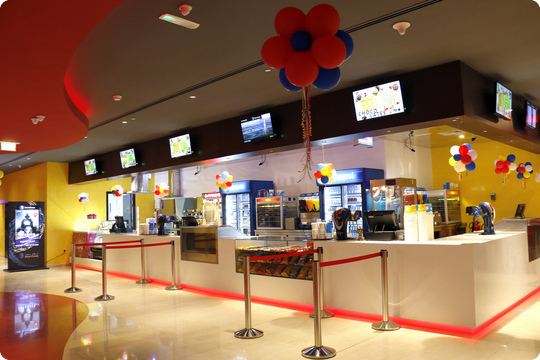
VOX Cinemas – Nation Towers Galleria (May 2016)
VOX Cinemas – Yas Mall (May 2016)
VOX Cinemas – City Centre Deira (May 2016)
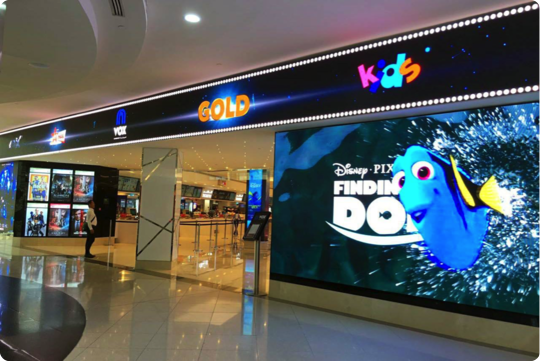
VOX Cinemas – Fujairah City Centre (May 2016)
VOX Cinemas – Ajman City Centre (July 2016)
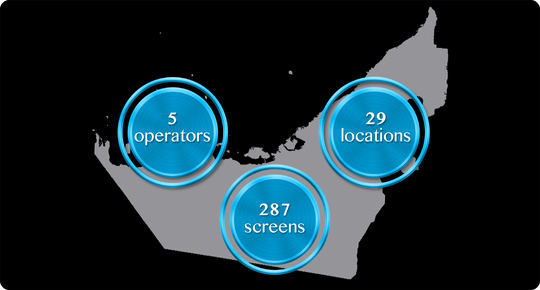
2. Investment in Content
Back in 1991, Terminator 2 made headlines for being the first movie to cost $100 million to produce, making it the most expensive film ever by a fairly large margin. Today, T2 doesn’t even crack a list of the Top 200 most expensive movies ever made. That’s right! Since T2’s release, more than 200 movies have been made with reported budgets well worth of its 100 million dollars.
Look at 2016 alone. Hollywood is forecasted to have spent an estimated $2B in producing 2016’s Q2 major blockbuster releases.
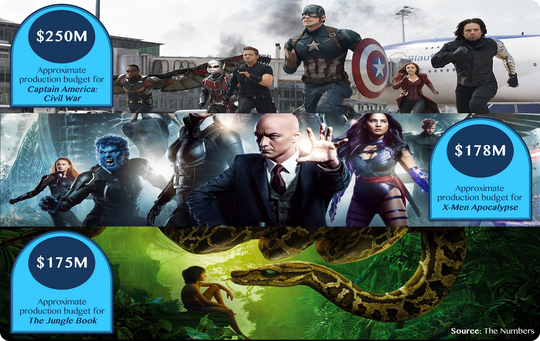
2016 is also the biggest year on record for superheroes movies…
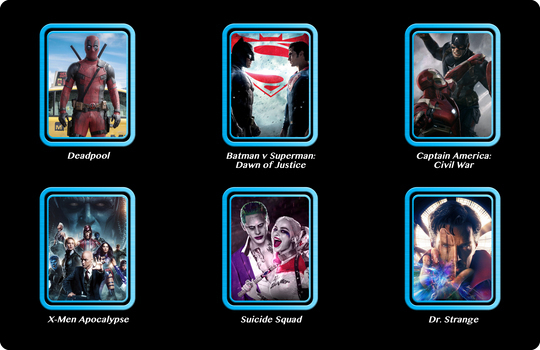
..and films based on video games.
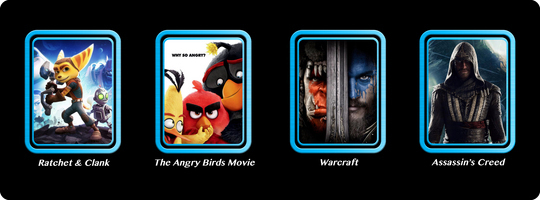
It was said that 2015 was a record-breaking year at the box office, however 2016 is proving to be no different, and a lot more in expected from 2017.
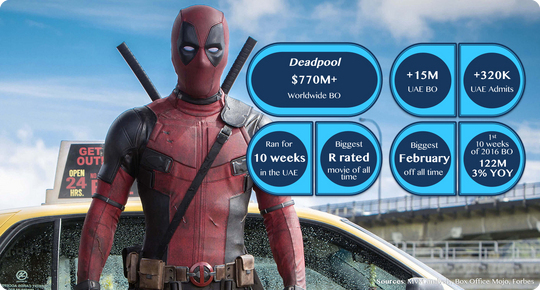
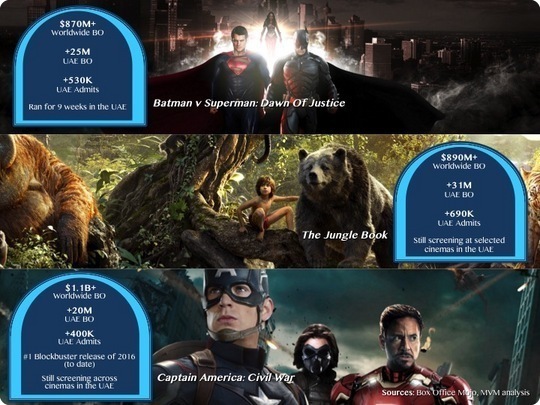
Films you may know of releasing in Q3 of 2016 – expected to make it BIG at UAE box office
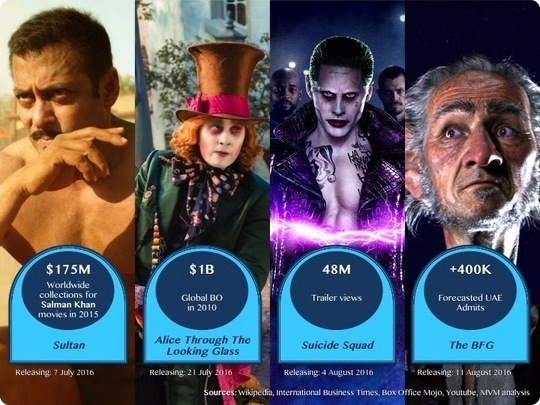
3. Cinema Remains An Important Local Media Touch-point
Combining the power of cinema with other formats of advertising ensures greater campaign effectiveness. And with the number of blockbusters releasing on a more frequent basis, cinema on-screen advertising has given brands an unparalleled opportunity to be as creative as the films that follow them.
Over the years, a number of brands have taken the leap to free themselves from the confines of advertising and explored the possibility of aligning their brand with a creative cinema execution. The result? Greater brand impact!
Top two integrated marketing campaigns of 2016 (to date) that included cinema:
Jeep – Product Placement in Batman v Superman: Dawn of Justice (March 2016)

Remember that scene from Batman v Superman: Dawn of Justice where Bruce Wayne (played by Ben Affleck) gets behind the wheel of the Jeep Renegade and is seen driving towards the destruction and nimbly navigating his way through the mayhem?
FCA US LLC and Warner Bros. Pictures joined forces for a one-of-a-kind co-branded partnership that included branded TV and cinema spots featuring the Jeep and Dodge brands, plus social/digital extensions that created powerful consumer engagement leading up to the official launch of Batman v Superman: Dawn of Justice.
MVM featured onscreen advertising spots for the commercial across our circuit of cinemas – integrating the same before each Batman v Superman: Dawn of Justice session.
Additionally, as part of the campaign, MVM offered an online banner for Jeep on the Reel Cinemas website, which when clicked on drove traffic to the BATTLE OF THE RENEGADES website – a thrilling interactive online experience where the viewer drives the story.
Nestle – 4DX Cinema Advertising (March 2016)

For brands launching a product with a new flavour or taste, 4D cinema technology can help ‘pack a punch’ with the feature of ‘smell’, and that’s exactly what Nestle KitKat capitalized on when launching its new line of KitKat senses (hazelnut wafer bars).
Nestle screened a 2D commercial with a ‘nutty twist’ – complemented by a scent of rich, mouth-watering hazelnut. The campaign – coordinated by MVM and VOX Cinemas, screened at VOX Cinemas Deira City Centre, Mirdif City Centre and YAS Mall (Abu Dhabi).
Other advertising mediums utilized for the launch included: Radio, YouTube, Social Media and an activation in partnership with UBER.
Cinema ensures consistent total audience delivery across all periods.
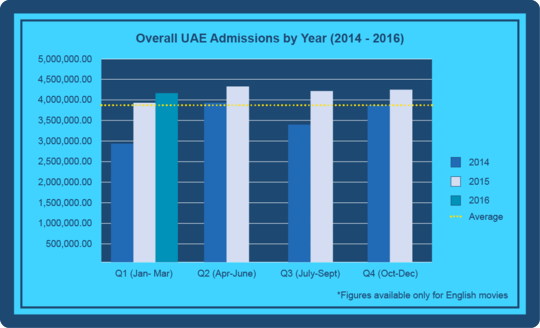
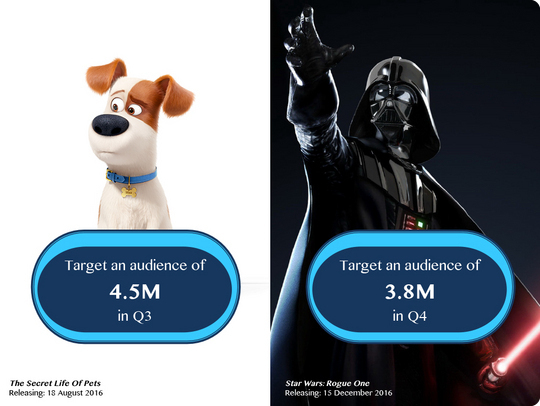
The medium truly delivers an ultimate environment for advertisers – distraction free environment with high ad recall, and a captive audience who cannot fast-forward or block ads.
Additionally, the value of integrated campaigns utilizing both on screen and off screen messaging has the potential to double, or even triple the impact a brand can make on moviegoers.
Embrace the value proposition of cinema advertising and make it an integral part of your media plan today! Contact a member of our sales team for more information on how you could align your brand with an upcoming blockbuster.
Year-on-year, with the sheer glut of blockbusters releasing on a more frequent basis, cinema on-screen advertising has given brands an unparalleled opportunity to be as creative as the films that follow them.
The more powerful and effective a cinema campaign, the greater the emotional response from an audience!
Keeping this in mind, here’s why 4D cinema advertising can achieve greater brand impact:
1. Encourages an active/assertive viewer experienceAudiences can’t just let a 4D movie happen to them; the overall experience demands that they be engaged in an active manner with what’s happening on screen. Similarly, 4D cinema campaigns guarantee audience engagement from start to finish.
Client Example:
Cadillac CTS – V Coup
Creative Execution:
To illustrate how the Cadillac V-series is ‘The Perfect Storm’, Leo Burnett created a 4D cinema campaign – working closely with MVM and VOX Cinemas, which screened at VOX City Centre Deira and Mirdif City Centre.
First, a 3D execution of the TVC was produced in order for viewers to virtually enter the eye of the storm. Then, with the assistance of large industrial fans installed on the walls of the cinema, the audience was able to feel the power and actively engage with the commercial.
2. Stimulates greater interest in a product, service or experience
Featuring motion seats and effects like rain, fog, wind, water, lightning and scents, 4D movies take audiences on a live action, immersive journey. Likewise, a 4D campaign has the power to navigate an audience on a strategically developed, brand specific virtual-reality tour – thus sparking heightened levels of interest.
Client Example:
Atlantis The Palm
Creative Execution:
To immerse the audience in the dazzling world of imagination, pleasure and 5-star luxury – ‘Check Into Another World’, Atlantis together with a Dubai based creative agency that worked closely with MVM and VOX Cinemas, utilized 4D cinema technology in the campaign that screened at VOX City Centre Deira and Mirdif City Centre.
Using a gentle breeze to delight, refreshing scents (ocean and gardenias) to relax and revitalize, and flying, rolling and bouncing seat motions to create a sense of joy, the campaign transported audiences to discover the luxury service and in-house experience extended to guests and visitors of the Atlantis.
3. Subconsciously triggers the element of ‘want’
Taste and smell are separate senses with their own receptors, yet they are intimately entwined to produce some of the basic sensations of everyday life. As the saying goes: “If you smell it, you will want to taste it.”
For brands launching a product with a new flavour, 4D cinema technology can help ‘pack a punch’ with the feature of smell.
Client Example:
Nestlé KitKat Senses – Hazelnut
Creative Execution:
For the launch of KitKat Senses Hazelnut, Nestlé screened a 2D commercial with a ‘nutty twist’ – complemented by a scent of rich, mouth-watering hazelnut. The campaign – coordinated by MVM and VOX Cinemas, screened at VOX Cinemas city Centre Deira, Mirdif City Centre and YAS Mall (Abu Dhabi).
4. Enhances audience engagement through virtual reality
Quite a few movies are still made for the purity of the storyline, acting and directing capabilities. However, the movies that perform relatively well at UAE box office belong to action, adventure and animation genres – which of course, work well with 4D cinema technology.
Therefore, 4D most often appeals to advertisers with an aim to engage an audience through means of sheer action and adventure. Why? Because the overall experience is live, engaging, adrenaline pumping and fun!
Client Example:
Toyota – FJ Cruiser Xtreme
Creative Execution:
In the face of an already crowded off-road segment, and confronted with the extreme challenge of launching the 2014 FJ Cruiser Extreme, Toyota together with GMASCO (working closely with MVM & VOX Cinemas) executed a 4D campaign – shortlisted at Dubai Lynx 2015, to achieve stand-out awareness of the many wonders of the formidable 4×4.
A region-first 4DX commercial that screened at VOX Cinemas City Centre Deira and Mirdif City Centre – alongside blockbuster movies Need for Speed and Fast and Furious 6. The ad utilized augmented environment effects such as seat motion, wind, rain, fog, lighting and scents to supplement the action sequences in standard video format – thereby giving the audience the feeling of every bump, splash and win… right in their seats!
Over recent years, more and more cinema operators in the region have invested in cutting-edge cinema concepts and technology (3D, 4D, IMAX) – pushing the boundaries of cinema-going.
4D is the next step in the movie-going evolution – engaging audiences to be part of the adventure whilst experiencing the entirety of virtual realty. This has also offered advertisers new and exciting formats of cinema advertising – all guaranteed to create greater brand impact.
It’s time to free yourself from the confines of advertising and explore the possibility of aligning your brand with a 4D movie releasing over the months ahead.
MVM is the official cinema advertising partner of VOX Cinemas with 4DX screens at City Centre Deira, Mirdif City Centre, Mall of the Emirates and Yas Mall (Abu Dhabi), and Reel Cinemas with an MX4D screen at The Dubai Mall.
Contact a member of our sales team for more details.
Sources: WHAT’S ON, Dubai Lynx, MENA Cristal, Dubai PR Network
There is no doubt as to what UAE’s audiences want to watch when they hit the multiplexes – can you guess? Based on 2014 box office receipts, 58 per cent spent on watching action/adventure movies as they spent an estimated $157.8 million (Dh579 million) across all non-Arabic film. They spent a further $4 million on Arabic language films that year.
In 2015, the grand total spent on all-language cinema swelled to $189 million as the UAE witnessed the addition of more cinema screens.
According to a report by Northwestern University in Qatar, in partnership with the Doha Film Institute, “while Egyptian films claimed nearly all box-office revenues among Arabic-language films in Egypt and UAE since 2012, Lebanese films have made nearly two-thirds of box office revenues in their own country over the same period.”
“In two of the biggest cinema markets – Lebanon and Egypt – Arabic-language films earned more at the box office per title than non-Arabic films. This is despite Arabic-language films claiming only a fraction of box-office revenues overall throughout the region.”
2017 is another big year in terms of blockbuster releases and offers a diverse slate of action/adventure movies over the months ahead. Visit our trailer park to view the trailers of the latest movies releasing in the UAE.
Source: Gulf News
In the latest round of the ‘Audi Challenges Arabia’ campaign, a fan challenged Audi Middle East to light up a football pitch, a challenge Audi couldn’t refuse.
With the help of 22 Audi Q7’s and their Matrix LED headlight technology, Audi Middle East helped an ambitious Omani boy towards reaching his dream. As a first and exclusive for the Middle East region, Audi Middle East has launched a once in a lifetime opportunity.
The ‘Audi Challenges Arabia’ initiative asks fans to nominate an Audi challenge that would become a reality for them.
This is the third challenge to be delivered by Audi Middle East since initiating the ‘Audi Challenges Arabia’ campaign in the region. The first challenge took place during August 2015 at the Dubai Autodrome with the ‘Audi R8 adrenaline’ challenge. The second challenge was the ‘Audi Elevation challenge’, where an Audi RS 7 raced the elevator of the tallest building in the world – Burj Khalifa.
More than 4,000 challenges have been submitted since the start of the Audi Challenges Arabia campaign. The third successful challenge to be made into reality came from an Audi fan, who submitted the request to light up a football pitch. Audi Middle East accepted the challenge, and also helped a 13 year old – Zakaria Daoud, Omani boy take a step forward towards his dream to become a professional football player.
Zakaria Daoud, who lives in a remote village located in the mountains of Oman- with no proper paved roads, dreams of becoming a professional football player. Yet the village lacks any facilities such as a football pitch where he can develop his talent and play regularly with his friends.
Audi Middle East extended the challenge of lighting up a football pitch and surprised the child by building a new football field for Zakaria to practice his favorite game with his friends.
With the help of 22 new Audi Q7’s, the pitch was built in the mountainous area of Al-Rustaq, which is located 1,500 meters above sea level and can only be reached by a 40 kilometer rocky off road route.
The second part of the challenge was completed with the help of Audi Q7’s Matrix LED technology, which completely illuminated the football pitch and surprised the village children with their new pitch.
The commercial for the third challenge under Audi Challenges Arabia screened at MVM’s circuit of cinemas in Dubai and Abu Dhabi.
Fans can also watch previous #AudiChallengesArabia videos that Audi Middle East has already achieved on the bespoke microsite www.audichallengesarabia.com.
There’s no denying that in times of an economic downturn, every dollar spent will be scrutinized and will need to work harder.
With the first six months of 2016 forecasted to be the toughest for the economy of the MENA region since 2009, its fair to say that clients will be more reluctant to just ‘toss’ money towards media, and will therefore most likely only invest in advertising that works in the right channel and at the right moment – targeting the right audience.
So why is cinema the safest and the right medium to invest in during an economic downturn?
Well, history tells us cinema and recessions are like a peanut butter and jelly sandwich – the perfect combination! Similar to how cinema emerged as one of the least affected industries during past economic woes, the next six months seem to be no different in the UAE (hello, Batman vs. Superman: Dawn of Justice, and an incredible line-up of blockbuster movies releasing in 2016).
Take the Great Depression (1929 -1939) as another example – from failed farmers to working mothers and displaced children, the great depression invaded homes across the U.S. Twenty-five percent of the country was unemployed during the peak of the depression (1933), while even more just barely made ends meet. Despite the agonizing economic hardship faced by nearly all of the country, 60-70 million Americans still packed into theaters each week. You wonder, what made sitting in a theater for an hour and a half worth a hard-earned 15 cents?
As explained by Dixton Wector (historian), “the content of motion picture was designed for escape – the majority reflecting the tastes of tired and jaded adults seeking a ‘never-never land’ of luxury, melodrama and sentiment.”
If you are a moviegoer who lived in the UAE between 2008 and 2010 – when the economic downturn was in full swing, you might still recall the somewhat crowded multiplexes- spanning all ages. But why frequent cinemas when unemployment rates were at an all time high, businesses were experiencing discouraging times, and a great sense of depression loomed the region? The simple answer: that’s the power of the movies! People still want to be entertained, perhaps more so in tough times.
Week after week (between 2008 to 2010) movies performed relatively well at the UAE Box Office:
Cinema truly delivers an ultimate environment for advertisers, and over the years, many advertisers have embraced the value proposition of cinema advertising – a distraction free environment with high ad recall, and a captive audience who cannot fast-forward or block ads. Additionally, the value of integrated campaigns utilizing both on screen and off screen messaging has the potential to double, or even triple the impact a brand can make on moviegoers.
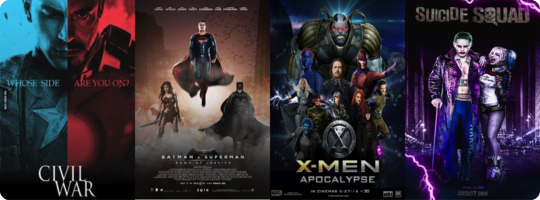
Cinema remains a relatively cheap form of entertainment here in the UAE, especially compared with eating out, or a night down at a pub. Coupled with a mind-blowing line-up of movies releasing this year, and a range of cinema experiences the UAE has to offer – IMAX, 3D, and 4DX, cinemas will continue to attract moviegoers in numbers this year too- thus, there’s no friendlier medium than cinema for advertisers to invest in during times of a slower and bumpier economy.
Contact a member of our sales team for a detailed list of this 2016’s movie-line up, and for more information on our cinema advertising packages.
Sources: boxofficemojo.com, The Telegraph, xroads.virginia.edu, The Hollywood Reporter, and Campaign
VUE Cinemas in the UK and Ireland commissioned leading scientists from the Thrill Laboratory and neuroscientist Patrick Fagan from Goldsmiths to undertake a phenomenal 2D vs. 3D public study in 2015.
The Study:
Moviegoers participated in a scientific test at VUE Piccadilly to understand the effect 3D films had on the brain.
The study demonstrated that watching films in 3D gives a mental boost, enhancing speed of reaction and the brain’s ability to process information.
Procedure:
Using brain monitoring headsets which monitored 14 different parts of the brain – each part of the brain indicating the different ways in which we process what we see on the screen, how we feel emotionally, and the kind of things we want to so (scream/jump out of the seat). The collection of these bits of information was fed into computer technology were scientists were able to work out levels of excitement, engagement, and ultimately levels of enthrallment the audience experienced in 3D.
Results:
Conclusion:
The audience reflected a good mix – men, women, older and younger people who experienced and consumed 3D content differently. 3D films excited everybody – in slightly different ways. On the whole, everybody enjoyed a unique and intense experience.
VUE is one of the leading cinemas operators, owning the most modern state-of-the-art multiplex cinema circuit in the UK and Ireland – with almost 800 screens at over 80 cinemas.
Interested in playing your ad in 3D? MVM also offers 3D production and UP conversations from 2D to 3D.
Source: sawa.com